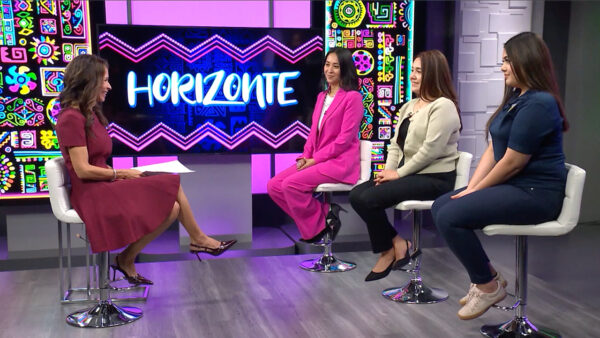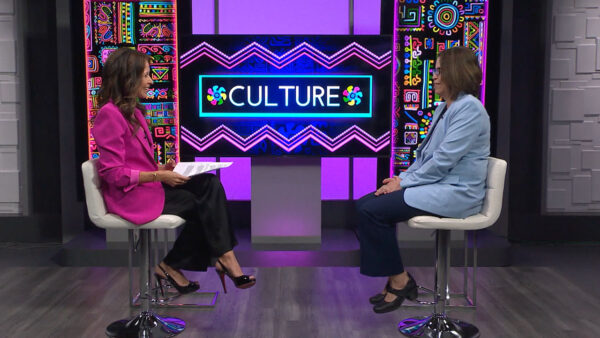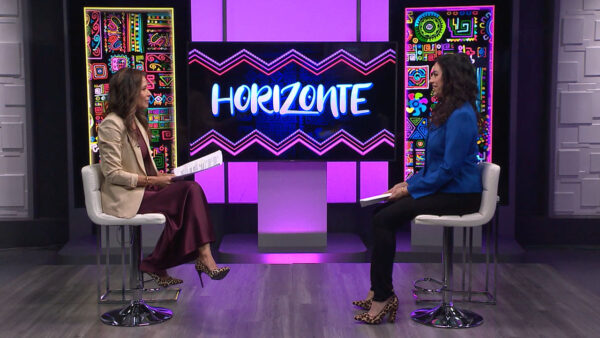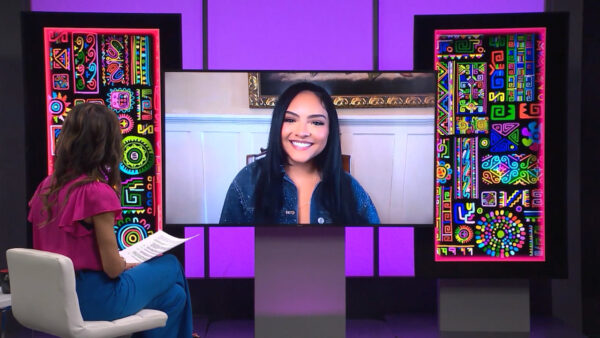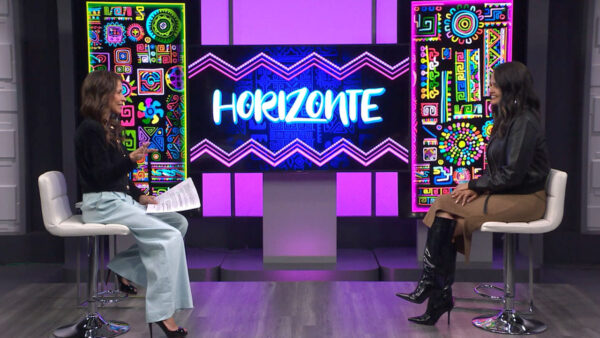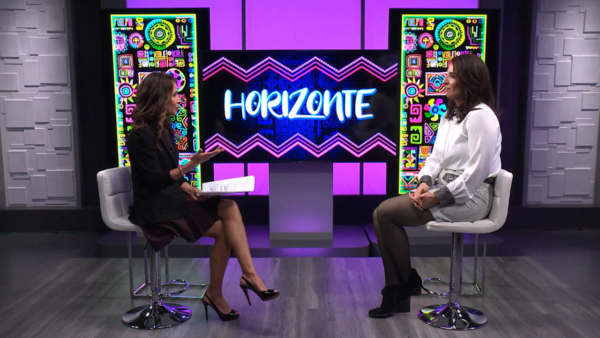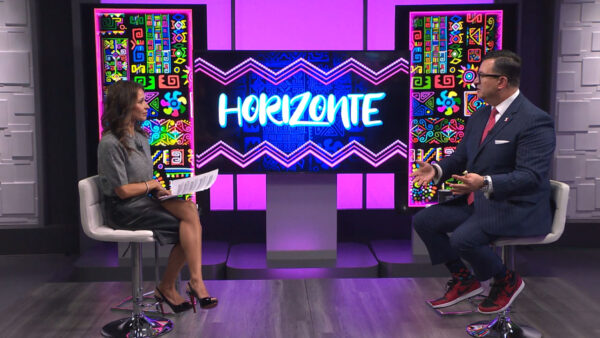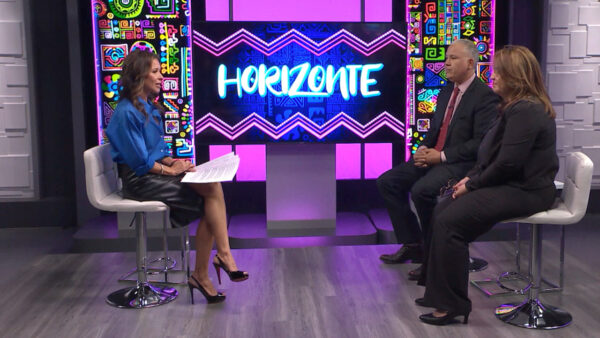The first comprehensive solo exhibition by contemporary Mexican-American artist Eduardo Sarabia, “Moctezuma’s Revenge,” will feature more than 40 works of art from both previous and new bodies of work in a variety of media. Arizona State University Art Museum curator Julio Cesar Morales and artist Eduardo Sarabia talk about the exhibition.
José Cárdenas: In sounds of Cultura SOC, The first comprehensive solo exhibition of works by contemporary Mexican-American artist Eduardo Sarabia opens this weekend at the ASU art museum. The exhibition was curated by Julio César Morales and will feature more than 40 works of art from both new and previous bodies of Sarabia's work in a variety of media. Joining me tonight is Arizona State University art museum curator, Julio César Morales. Also here is artist Eduardo Sarabia. Gentlemen thank you for joining us on "Horizonte." I want to start with the exhibition, and then we want to get some detail both about that and about your background, Eduardo. We've got some images we want to put up on the screen. The exhibition is entitled La Venganza De Moctezuma, Montezuma's Revenge. This first piece illustrates that very graphically. And then the next one repeats that same title. This one starts to get into what's kind of the theme about what Montezuma's Revenge really is about these days.
Julio César Morales: Right, and I think one of the interests of myself as a curator is the work of Eduardo as an artist and I was fascinated in the way he mixes mythology with history and contemporary history now so I think the idea of Montezuma's Revenge that we all know in the United States is very different from the idea that Eduardo had for the exhibition and one of the key elements is perhaps Montezuma's Revenge is not something that happens to tourists when they go to Mexico and they drink the water but perhaps Montezuma's Revenge is what we know as drug wars right now between cartels and the involvement between the U.S. and Mexico.
José Cárdenas: And if we can get that image back up on the screen, the one we had before, Eduardo you've got these parrots, you've got the globe, and these are images really from the drug culture. Explain that to us.
Eduardo Sarabia: Well, this particular image I tried to mix mythology and contemporary culture and everything that's happening today and it's a mythical kind of bird in the Aztec culture and it's a bird that's found in the south of Mexico. And it's what Montezuma's head dress is made out of and there's a lot of myths in Mexico around that and this image is the world in flames and Montezuma's revenge kind of like being poured all over the world.
José Cárdenas: And we've got some other images we want to put on the screen now. One of the things that took you to Mexico, you were born in L.A. and I want to talk about your background a little bit but you went to Mexico in part to do ceramic work and this is one of the pieces in the exhibition. Explain this one to us.
Eduardo Sarabia: Yes. I like using typical ceramic bases and what I liked, I liked decorating them with contemporary motifs and using traditional elements of Mexico. This is a typical vase, the blues and whites, and I put images that kind of relate to this contemporary lifestyle. And putting them inside of history as kind of a device to record what is happening.
José Cárdenas: And in this particular case, if we had a closeup, I don't know if we can get one, it would show rifles and the reference I guess to one of the centers of the drug trade.
Eduardo Sarabia: It's a symbol in popular culture that has rifles, marijuana leaves, some of them have women, and it's part of the contemporary culture of this Narco culture that we're talking about.
José Cárdenas: Julio, this exhibition was in Denver but it was smaller.
Julio César Morales: It was a smaller version that I went to see the exhibition, I just fell in love with it and essentially I was really interested in bringing it to Arizona but extending the work itself but also having Eduardo here in Arizona and he came by for, you know, he was here in residence for a year and he came for a couple of trips and he was really influenced by Arizona, the landscape of Arizona, the politics of Arizona, the U.S. and Mexico border, and I think one of the important things about the vases is that right now, we're seeing a lot of young men who are joining drug cartels in Mexico and upon doing a lot of research, we learned --
José Cárdenas: And this is a closeup I was looking for here.
Julio César Morales: This to me really symbolizes how people are viewing this subculture and a lot of people are opting to live their full life in two years as opposed to a lifetime of poverty.
José Cárdenas: That was it that attracted you to Eduardo's work?
Julio César Morales: I think there's certain parallels between my interests, my own artwork and also with what Eduardo's work is about. We both are bicultural people, having --
José Cárdenas: You're from Tijuana.
José Cárdenas: I'm from Tijuana. He's from L.A. but he has family in Mazatlán. So a lot of the work touches immigrant experience and also what is really going on in Mexico and in the United States. And so Eduardo has a unique perspective in being Mexican-American and living right now in Guadalajara.
José Cárdenas: As we indicated, you grew up in L.A. and interesting background in terms of how you got interested in art and the steps that occurred in your development as an artist.
Eduardo Sarabia: I grew up in the housing projects and it was -- and I had a lot of teachers of mine who saw some kind of creativity or saw some kind of drawing ability in me and pushed me to pursue after school kind of art classes and weekend art classes.
José Cárdenas: That was a creativity that expressed itself in many ways. We talked a little bit off-camera about you being a chess champion in Los Angeles.
Eduardo Sarabia: One of my teachers taught me how to play chess and I was a chess champion for a couple of years.
José Cárdenas: And your interest in art took you to all of places the Soviet Union when it was still the Soviet Union.
Eduardo Sarabia: Yes, when I was 13, I won a grant and my parents sent me to the Soviet Union for three months and we worked on a mural with condition from the Soviet Union and it was a project that kind of developed through just from kids like -- from art school like it was just something that they pushed me to do.
José Cárdenas: Your first exhibition focused on your life growing up in Los Angeles?
Eduardo Sarabia: Yes.
José Cárdenas: What kinds of images?
Eduardo Sarabia: I think it was the images I was used to seeing, the murals on the streets kind of graffiti, a lot of my friends were in gangs. It had to do with more of this romanticism, growing up in this environment.
José Cárdenas: What's the importance of bringing artists such as Eduardo to Arizona? You touched on it a little bit when we were talking a moment ago. Why is it important?
Julio César Morales: It's important for us at the museum to bring in artists from Mexico, from Asia, from all over the world to really see and kind of explore Arizona and see some of the natural landscape but also look into the politics and the social climate that we're experiencing right now and kind of learning from the artists and their translation of what we're experiencing here and essentially, ASU is a great model in which we can bring artists to fully develop projects and maybe sometimes also incorporate different types of -- different types of ways of them working and perhaps collaborating with other departments at ASU, as well.
José Cárdenas: Before we go too far we should mention when the exhibit starts and how long it's going to be here.
Julio César Morales: The exhibition, we have a soft opening so essentially on Saturday, January 25th, the exhibition will be open to the public and the actual reception will be on Valentine's Day, February 14th from to 6:30-9:30pm. And it's going to be our season opening reception as well so we'll have other exhibitions on display.
José Cárdenas: And how important is it to you to have exhibitions that kind of illustrate this duality and bicultural background?
Julio César Morales: I think, you know, because artists have a unique perspective and I think like Eduardo's work I kind of see it as an journalistic approach to art making so I also try to put together exhibitions that perhaps you get information from, that perhaps instead of reading the New York Times, instead of reading the local newspaper that you get information, that you get information that the artist has done extensive research and you get something instead of just seeing the beauty of it that you also do get something intellectual, something that you can gather and perhaps create social change based on the images or based on the work itself.
José Cárdenas: Now, Eduardo as I understand it, your second exhibition kind of was an exploration at least in one sense of your Mexican roots. Searching for the gold.
Eduardo Sarabia: It was a project. I grew up sending the summers in Mazatlán. My grandfather would tell me about this treasure he was looking for. When he passed away, my grandmother save me all his maps and all the research he had done.
José Cárdenas: He was serious.
Eduardo Sarabia: He was serious. He was serious. He looked for the gold for 50 years in the mountains. And when he passed away, I receive all the information and I thought it would be a great thing to try to fulfill his dream and try to find it. But really naive at the time I went and I just realized it was impossible to search because there was a drug war going on. So it was hard for me to go out and freely look for this treasure.
José Cárdenas: I want to talk about the drug scene that's present in this particular exhibition and your work but at a certain point of time you decided to move to Mexico. Why?
Eduardo Sarabia: About 13 years ago, I got a phone call from this guy who owns a ceramics factory, he had seen my work in an art fair in Miami and he thought that I could do amazing things with him and his ceramic factory.
José Cárdenas: Had you worked in ceramics before?
Eduardo Sarabia: I had not worked in ceramics before. I went out there, he invited me and I liked working with him, I liked the medium. I think for me it was a great work to tell these stories that I was trying to tell and use these historic kind of, you know, examples from like Egyptian vases that kind of told the mythological stories and incorporate them in this interest that I had, the new interest with what was happening in Mexico.
José Cárdenas: Now, you've spent some time in Germany as well but you now consider Guadalajara your home?
Eduardo Sarabia: I do, I was. I opened a tequila bar in Berlin. And I ran it for about a year. And then it turned into an art project where I was inviting Mexican artists to Berlin to D.J., play music, bar tend, project films, performances, make objects for the bar. And it was a great project that kind of went -- ended up traveling a little bit. In Berlin it was for a year.
José Cárdenas: This sounds a little bit like the great tradition of the Mexican artists, Rivera and others, who studied in Paris and parts of Europe.
Julio César Morales: Well, actually the funny thing is that we actually met in Istanbul, because he took his tequila bar to the Istanbul biannual, where I was an artist. That's how I ended up meeting Eduardo and I ended up playing music and he loved the music and we stayed in touch and we ended up in touch and we ended up being part of sort of seminal exhibition called Phantom Sightings, art after the Chicano movement that opened at the Los Angeles county art museum. It traveled here to the Phoenix art museum in 2007 or 2008. And that's how we began a dialogue about we need to work one day together and I think we saw the opportunity when I saw his work in Denver and I saw this was a great opportunity to work with him and he was very open to being influenced by Arizona and one of the projects that you'll see is his first video project at the exhibition that is influenced by the ceremonial dance of the deer. And he did a portrait of that.
José Cárdenas: We're almost out of time. We have one more image up on the screen quickly. It's the famous volcano outside of Mexico City. What does this represent for you?
Eduardo Sarabia: While I was doing the research and trying to mix these mythologies of Montezuma's Revenge and past mythologies, I got really fascinated with the 2012 Mayan prophecies and I was speaking to Mayan shaman and they don't leave in the destruction of the world.
José Cárdenas: I'm sorry we're out of time but people will be go and see the exhibition and get more information, thank you both so much for joining us on "Horizonte." That's our show for tonight. From all of us here at Eight and "Horizonte," I'm José Cárdenas. Have a good night.
Julio Cesar Morales:Curator, Arizona State University Art Museum; Eduardo Sarabia:Artist;













